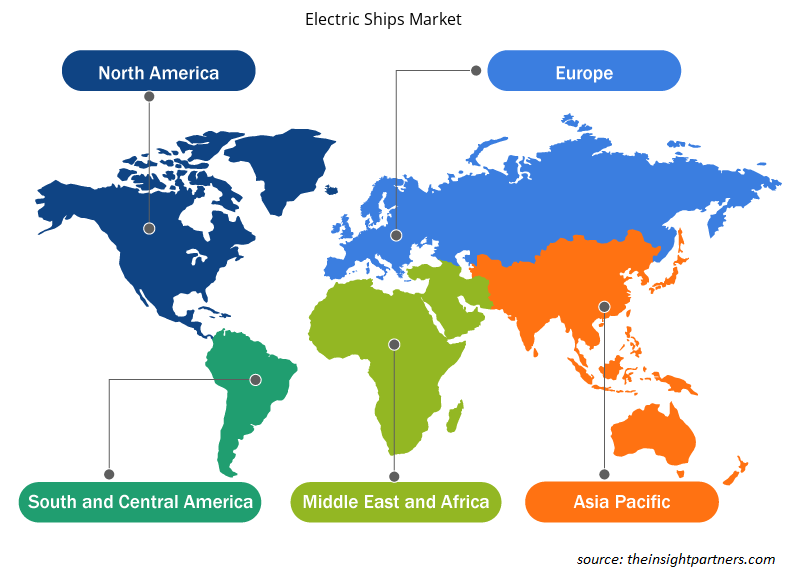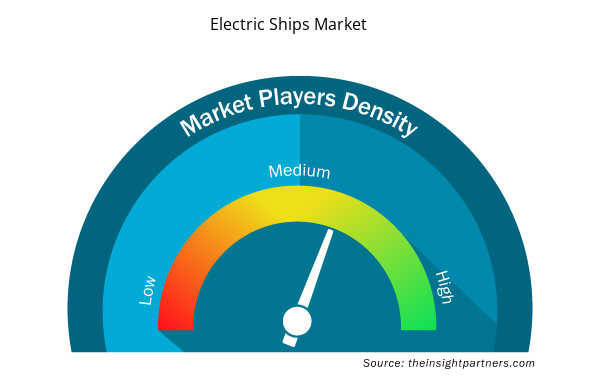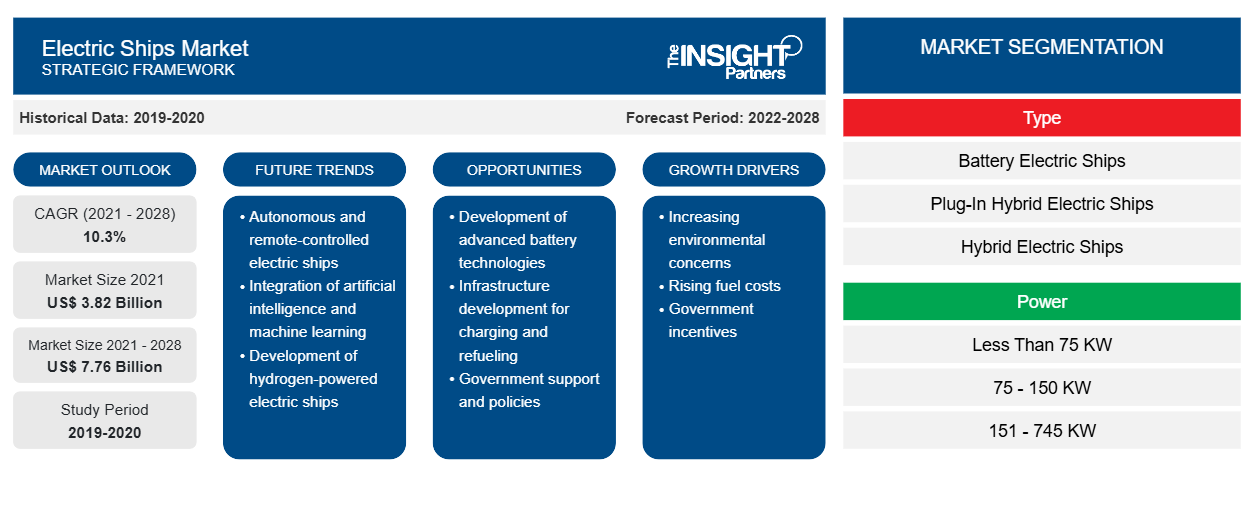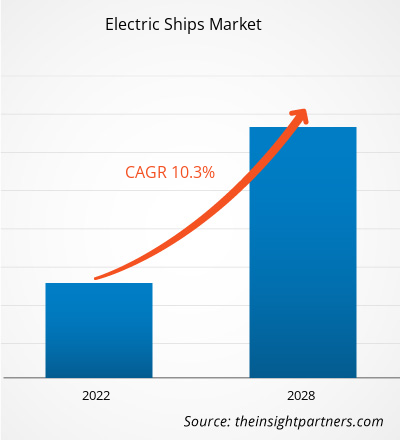電気船市場は2021年に38億2,000万米ドルと評価され、2021年から2028年にかけて10.3%のCAGRで成長すると予測されています。
電気ボートとは、主な推進技術が電気駆動システムであるボートまたは船のことです。タグボート、フェリー、貨物船、はしけから、観光船、漁船、クルージングヨット、無人潜水艇 (UUV) まで、完全バッテリー電気、水素燃料電池電気、電気ハイブリッドボートまたは船が含まれます。電気船は、従来のディーゼルエンジン船とは異なり、電気で駆動されます。これらの船は、電気モーターを駆動するための電源としてバッテリーストレージデバイスを使用します。電気船では、リチウムイオンバッテリー、鉛蓄電池、燃料電池など、さまざまな種類のバッテリーを使用できます。電気船は主に、完全に電気で航行する内陸水路のフェリーや小型客船です。1回の充電で約80 kmの短距離しか移動しません。さらに、低出力が必要な軽量船では、太陽光発電船も使用されます。ただし、貨物船は重量が重いため、完全な電気システムでは電力要件を満たすことができません。そのため、貨物船はディーゼル電気ハイブリッドシステムを利用しています。
要件に合わせてレポートをカスタマイズする
このレポートの一部、国レベルの分析、Excelデータパックなど、あらゆるレポートを無料でカスタマイズできます。また、スタートアップや大学向けのお得なオファーや割引もご利用いただけます。
- このレポートの主要な市場動向を入手してください。この無料サンプルには、市場動向から見積もりや予測に至るまでのデータ分析が含まれます。
COVID-19パンデミックが電気船市場に与える影響
COVID-19パンデミックは、電気船市場に悪影響を及ぼしました。パンデミックは、人間の移動に前例のない世界的な影響をもたらしました。海洋では、人間の移動に対する厳しい制限と商品の消費の変化により、船舶ベースの活動が影響を受けています。いくつかの国は、COVID-19パンデミックのためにクルーズ産業を閉鎖しました。しかし、いくつかのクルーズラインは、パンデミック中に活動を再開しようとしています。海洋での人間の活動はCOVID-19パンデミックによって根本的に変化しており、港湾の制限や消費パターンの変化が、複数の海事部門、漁業、旅客フェリー、クルーズ船に影響を与えているとの報告があります。ただし、一部の地域では、ロックダウン中に商品の輸送が不可欠であると宣言され、電気船市場に有利な機会が生まれました。
電気船市場の洞察
船舶の改造におけるハイブリッドおよび電気推進システムの採用増加
船舶の改造は関心を集めており、船主/造船業者は既存船舶の寿命を延ばそうとしています。このようなプロセスは、燃料消費を削減し、費用対効果の高い手順として最新の環境に優しいソリューションを常に利用できる機会を提供します。改造は海事業界では一般的な慣行になりつつあります。造船業者は自動化、新造船の統合、および既存船舶のハイブリッドおよび電気推進システムの改造に移行しています。このシステムは、フェリー、コンテナ船、クルーズ船、タグボート、一般貨物船など、改造の可能性が非常に高い時代遅れの船舶を改造するための便利な選択肢です。造船業者は、新造船を購入するよりも比較的安価なオプションであるため、ハイブリッド電気推進システムまたは完全電気推進システムで船舶を改造することを選択します。さらに、いくつかのヨーロッパの造船業者は、現在の船隊をハイブリッドおよび電気推進システムで積極的に改造しています。たとえば、2020年3月にRiviera Maritime Media Ltdが発表した記事によると、オフショア供給船(OSV)の所有者は、ディーゼル電気/ LNG駆動の船隊をバッテリーハイブリッド推進に改造する投資を行っており、これはチャーター業者、所有者、そしてノルウェーの環境問題に利益をもたらしています。これらの要因により、船舶の改造にハイブリッドおよび電気推進システムが採用されるようになりました。
タイプベースの市場分析
タイプに基づいて、電気船市場は、バッテリー電気船、プラグインハイブリッド電気船、ハイブリッド電気船に分類されます。ハイブリッド電気船セグメントは、2020年に市場をリードしました。ハイブリッド電気船が提供する信頼性は、補助推進システムの使用と高速化により、故障のリスクを減らし、より短い時間でより長い距離をカバーできるため、その需要を支えています。さらに、ハイブリッド電気船の推進は、電気(ディーゼル電気またはバッテリー電源駆動)または機械(直接ディーゼル駆動)の2つの方法で推進できます。さらに、世界中の船主や海運会社、物流会社は、燃料消費を抑え、運用コストを削減できるため、ハイブリッド電気船を好みます。低電力でのディーゼル電気推進と、さまざまな速度条件での内水航行で高電力が必要な直接ディーゼル駆動推進を使用すると、電気船の運用コストを削減できます。これは、ハイブリッド電気船の推進を使用して、利用可能なエネルギーを使用し、燃料コストを節約するよりスマートな方法です。
電気船市場で事業を展開する企業は、合併、買収、市場イニシアチブなどの戦略を採用して、市場での地位を維持しています。主要企業によるいくつかの開発を以下に示します。
- 2021 年 11 月、BAE Systems は、海洋事業者がゼロ排出を達成できるよう支援する次世代の電力および推進システムを発表しました。このシステムは、電気効率と船舶の航続距離を改善し、推進力を高め、設置を簡素化する柔軟なソリューションを提供します。
- 2020年9月、コロンブス(モビリティ企業)とフィエルストランド(造船会社)は、世界初の完全電動高速フェリーを納入する契約を締結しました。このプロジェクトは、欧州連合のホライズン2020研究イノベーションプログラムから資金提供を受けていました。
タイプに基づいて、電気船市場は、バッテリー電気船、プラグインハイブリッド電気船、ハイブリッド電気船に分類されます。 電力に基づいて、電気船市場は75kW未満、75〜150kW、151〜745kW、746〜7560kW、7560kW以上に分割されます。 航続距離に基づいて、電気船市場は50km未満、50〜100km、101〜1000km、1000km以上に分類されます。 船の種類に基づいて、電気船市場は、クルーズ船、フェリー、タンカー、ばら積み貨物船、漁船、駆逐艦、航空母艦などに分類されます。 地理的に、電気船市場は、北米、ヨーロッパ、アジア太平洋(APAC)、中東およびアフリカ(MEA)、南米(SAM)の5つの主要地域に分割されています。
電気船市場の地域別洞察
予測期間を通じて電気船市場に影響を与える地域的な傾向と要因は、Insight Partners のアナリストによって徹底的に説明されています。このセクションでは、北米、ヨーロッパ、アジア太平洋、中東、アフリカ、南米、中米にわたる電気船市場のセグメントと地理についても説明します。

- 電気船市場の地域別データを入手
電気船市場レポートの範囲
| レポート属性 | 詳細 |
|---|---|
| 2021年の市場規模 | 38億2千万米ドル |
| 2028年までの市場規模 | 77億6千万米ドル |
| 世界のCAGR(2021年~2028年) | 10.3% |
| 履歴データ | 2019-2020 |
| 予測期間 | 2022-2028 |
| 対象セグメント | タイプ別
|
| 対象地域と国 | 北米
|
| 市場リーダーと主要企業プロフィール |
|
電気船市場のプレーヤー密度:ビジネスダイナミクスへの影響を理解する
電気船市場は、消費者の嗜好の変化、技術の進歩、製品の利点に対する認識の高まりなどの要因により、エンドユーザーの需要が高まり、急速に成長しています。需要が高まるにつれて、企業は提供を拡大し、消費者のニーズを満たすために革新し、新たなトレンドを活用し、市場の成長をさらに促進しています。
市場プレーヤー密度とは、特定の市場または業界内で活動している企業または会社の分布を指します。これは、特定の市場スペースに、その市場規模または総市場価値に対してどれだけの競合相手 (市場プレーヤー) が存在するかを示します。
電気船市場で事業を展開している主要企業は次のとおりです。
- BAEシステムズ
- ダフィー・エレクトリック・ボート・カンパニー
- フィエルストランド AS
- Xショア
- ゼネラルダイナミック電動ボート
免責事項:上記の企業は、特定の順序でランク付けされていません。

- 電気船市場のトップキープレーヤーの概要を入手
企業プロフィール
- BAEシステムズ
- ダフィー・エレクトリック・ボート・カンパニー
- フィエルストランド AS
- Xショア
- ゼネラルダイナミック電動ボート
- フッティルーテン
- MAN エネルギーソリューション
- ポートライナー
- シーメンスエナジー
- ヴァードAS
- 過去2年間の分析、基準年、CAGRによる予測(7年間)
- PEST分析とSWOT分析
- 市場規模価値/数量 - 世界、地域、国
- 業界と競争環境
- Excel データセット



Report Coverage
Revenue forecast, Company Analysis, Industry landscape, Growth factors, and Trends

Segment Covered
This text is related
to segments covered.

Regional Scope
North America, Europe, Asia Pacific, Middle East & Africa, South & Central America

Country Scope
This text is related
to country scope.
よくある質問
The idea of retrofitting ships is gaining interest and is attracting shipowners/shipbuilders to extend the lifetime of their existing ships. Such a process provides a chance to reduce fuel consumption and stay up to date with the latest eco-friendly solutions as a cost-effective procedure. Retrofitting is becoming a common practice in the maritime industry. Shipbuilders are moving toward automation, integrating new build ships, and retrofitting existing ships with hybrid and electric propulsion systems. A hybrid-electric propulsion system is a convenient choice for retrofitting outdated ships. Ships have a large retrofit potential, including ferries, container vessels, cruise ships, tugboats, and general cargo ships. Shipbuilders choose to retrofit ships with a hybrid-electric propulsion system or a fully electric propulsion system as it is a relatively cheaper option than purchasing a new ship. These factors mentioned above have resulted in the adoption of hybrid and electric propulsion systems for retrofitting ships.
Nowadays, hybrid propulsion technology is commonly used for small vessels such as ferries. For instance, according to the article published by the Institution of Engineering and Technology, in January 2019, the UK shipbuilder Ferguson Marine had built Catriona, a £12.3 million (US$ 15.82 million) diesel-electric-battery-power hybrid ferry for CalMac to use on its Clyde and Hebridean routes. However, with the development of marine electric propulsion technology and alternative fuels such as fuel cells, there is a massive opportunity for manufacturers to work on hybrid-electric propulsion systems for larger ships. The stricter emissions targets have encouraged shipbuilders to install a hybrid propulsion system on existing or new vessels. The research & development (R&D) department for ABB marine activities in Norway stated that the hybrid propulsion systems significantly reduce both fuel consumption and emissions, according to the article published by the Institution of Engineering and Technology in January 2019. Therefore, with the growing emission control norms, the adoption of hybrid-electric propulsion systems is increasing among larger ships, creating a massive opportunity for manufacturing larger ships using hybrid-electric propulsion systems.
Europe dominated the Electric Ships market in 2020 with a share of 48.6% and is expected to continue its dominance by 2028. North America is the second-largest contributor to the global Electric Ships market in 2020, followed by Asia Pacific.
The major companies in Electric Ships market are BAE Systems, Duffy Electric Boat Company, Fjellstrand AS, X Shore, General Dynamic Electric Boat, Hurtigruten, MAN Energy Solutions, PortLiner, Siemens Energy, and VARD AS
The major Application in Electric Ships includes cruise ship, ferries, tankers, bulk carriers, fishing vessels, destroyers, aircraft carriers, and others. In terms of market share, the electric ships market was dominated by the ferries segment in 2020.
The electric ships market, by type is segmented into battery electric ships, plug-in hybrid electric ships, and hybrid electric ships. The Electric Ships market was dominated by the hybrid electric ships segment in 2020.
Trends and growth analysis reports related to Automotive and Transportation : READ MORE..
The List of Companies - Electric Ships Market
- BAE Systems
- Duffy Electric Boat Company
- Fjellstrand AS
- X Shore
- General Dynamic Electric Boat
- Hurtigruten
- MAN Energy Solutions
- PortLiner
- Siemens Energy
- VARD AS
The Insight Partners performs research in 4 major stages: Data Collection & Secondary Research, Primary Research, Data Analysis and Data Triangulation & Final Review.
- Data Collection and Secondary Research:
As a market research and consulting firm operating from a decade, we have published and advised several client across the globe. First step for any study will start with an assessment of currently available data and insights from existing reports. Further, historical and current market information is collected from Investor Presentations, Annual Reports, SEC Filings, etc., and other information related to company’s performance and market positioning are gathered from Paid Databases (Factiva, Hoovers, and Reuters) and various other publications available in public domain.
Several associations trade associates, technical forums, institutes, societies and organization are accessed to gain technical as well as market related insights through their publications such as research papers, blogs and press releases related to the studies are referred to get cues about the market. Further, white papers, journals, magazines, and other news articles published in last 3 years are scrutinized and analyzed to understand the current market trends.
- Primary Research:
The primarily interview analysis comprise of data obtained from industry participants interview and answers to survey questions gathered by in-house primary team.
For primary research, interviews are conducted with industry experts/CEOs/Marketing Managers/VPs/Subject Matter Experts from both demand and supply side to get a 360-degree view of the market. The primary team conducts several interviews based on the complexity of the markets to understand the various market trends and dynamics which makes research more credible and precise.
A typical research interview fulfils the following functions:
- Provides first-hand information on the market size, market trends, growth trends, competitive landscape, and outlook
- Validates and strengthens in-house secondary research findings
- Develops the analysis team’s expertise and market understanding
Primary research involves email interactions and telephone interviews for each market, category, segment, and sub-segment across geographies. The participants who typically take part in such a process include, but are not limited to:
- Industry participants: VPs, business development managers, market intelligence managers and national sales managers
- Outside experts: Valuation experts, research analysts and key opinion leaders specializing in the electronics and semiconductor industry.
Below is the breakup of our primary respondents by company, designation, and region:

Once we receive the confirmation from primary research sources or primary respondents, we finalize the base year market estimation and forecast the data as per the macroeconomic and microeconomic factors assessed during data collection.
- Data Analysis:
Once data is validated through both secondary as well as primary respondents, we finalize the market estimations by hypothesis formulation and factor analysis at regional and country level.
- Macro-Economic Factor Analysis:
We analyse macroeconomic indicators such the gross domestic product (GDP), increase in the demand for goods and services across industries, technological advancement, regional economic growth, governmental policies, the influence of COVID-19, PEST analysis, and other aspects. This analysis aids in setting benchmarks for various nations/regions and approximating market splits. Additionally, the general trend of the aforementioned components aid in determining the market's development possibilities.
- Country Level Data:
Various factors that are especially aligned to the country are taken into account to determine the market size for a certain area and country, including the presence of vendors, such as headquarters and offices, the country's GDP, demand patterns, and industry growth. To comprehend the market dynamics for the nation, a number of growth variables, inhibitors, application areas, and current market trends are researched. The aforementioned elements aid in determining the country's overall market's growth potential.
- Company Profile:
The “Table of Contents” is formulated by listing and analyzing more than 25 - 30 companies operating in the market ecosystem across geographies. However, we profile only 10 companies as a standard practice in our syndicate reports. These 10 companies comprise leading, emerging, and regional players. Nonetheless, our analysis is not restricted to the 10 listed companies, we also analyze other companies present in the market to develop a holistic view and understand the prevailing trends. The “Company Profiles” section in the report covers key facts, business description, products & services, financial information, SWOT analysis, and key developments. The financial information presented is extracted from the annual reports and official documents of the publicly listed companies. Upon collecting the information for the sections of respective companies, we verify them via various primary sources and then compile the data in respective company profiles. The company level information helps us in deriving the base number as well as in forecasting the market size.
- Developing Base Number:
Aggregation of sales statistics (2020-2022) and macro-economic factor, and other secondary and primary research insights are utilized to arrive at base number and related market shares for 2022. The data gaps are identified in this step and relevant market data is analyzed, collected from paid primary interviews or databases. On finalizing the base year market size, forecasts are developed on the basis of macro-economic, industry and market growth factors and company level analysis.
- Data Triangulation and Final Review:
The market findings and base year market size calculations are validated from supply as well as demand side. Demand side validations are based on macro-economic factor analysis and benchmarks for respective regions and countries. In case of supply side validations, revenues of major companies are estimated (in case not available) based on industry benchmark, approximate number of employees, product portfolio, and primary interviews revenues are gathered. Further revenue from target product/service segment is assessed to avoid overshooting of market statistics. In case of heavy deviations between supply and demand side values, all thes steps are repeated to achieve synchronization.
We follow an iterative model, wherein we share our research findings with Subject Matter Experts (SME’s) and Key Opinion Leaders (KOLs) until consensus view of the market is not formulated – this model negates any drastic deviation in the opinions of experts. Only validated and universally acceptable research findings are quoted in our reports.
We have important check points that we use to validate our research findings – which we call – data triangulation, where we validate the information, we generate from secondary sources with primary interviews and then we re-validate with our internal data bases and Subject matter experts. This comprehensive model enables us to deliver high quality, reliable data in shortest possible time.


 このレポートの無料サンプルを入手する
このレポートの無料サンプルを入手する